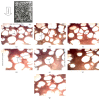Cell Colonization Ability of a Commercialized Large Porous Alveolar Scaffold
- PMID: 29386882
- PMCID: PMC5745715
- DOI: 10.1155/2017/8949264
Cell Colonization Ability of a Commercialized Large Porous Alveolar Scaffold
Abstract
The use of filling biomaterials or tissue-engineered large bone implant-coupling biocompatible materials and human bone marrow mesenchymal stromal cells seems to be a promising approach to treat critical-sized bone defects. However, the cellular seeding onto and into large porous scaffolds still remains challenging since this process highly depends on the porous microstructure. Indeed, the cells may mainly colonize the periphery of the scaffold, leaving its volume almost free of cells. In this study, we carry out an in vitro study to analyze the ability of a commercialized scaffold to be in vivo colonized by cells. We investigate the influence of various physical parameters on the seeding efficiency of a perfusion seeding protocol using large manufactured bone substitutes. The present study shows that the velocity of the perfusion fluid and the initial cell density seem to impact the seeding results and to have a negative effect on the cellular viability, whereas the duration of the fluid perfusion and the nature of the flow (steady versus pulsed) did not show any influence on either the fraction of seeded cells or the cellular viability rate. However, the cellular repartition after seeding remains highly heterogeneous.
Figures







Similar articles
-
Perfusion cell seeding on large porous PLA/calcium phosphate composite scaffolds in a perfusion bioreactor system under varying perfusion parameters.J Biomed Mater Res A. 2010 Dec 15;95(4):1011-8. doi: 10.1002/jbm.a.32927. Epub 2010 Sep 24. J Biomed Mater Res A. 2010. PMID: 20872752
-
Centrifugal seeding increases seeding efficiency and cellular distribution of bone marrow stromal cells in porous biodegradable scaffolds.Tissue Eng. 2007 Nov;13(11):2743-9. doi: 10.1089/ten.2007.0171. Tissue Eng. 2007. PMID: 17880269
-
Proliferation and osteogenesis of immortalized bone marrow-derived mesenchymal stem cells in porous polylactic glycolic acid scaffolds under perfusion culture.J Biomed Mater Res A. 2010 Mar 1;92(3):817-29. doi: 10.1002/jbm.a.32378. J Biomed Mater Res A. 2010. PMID: 19280635
-
Three-dimensional (3D) printed scaffold and material selection for bone repair.Acta Biomater. 2019 Jan 15;84:16-33. doi: 10.1016/j.actbio.2018.11.039. Epub 2018 Nov 24. Acta Biomater. 2019. PMID: 30481607 Review.
-
Modulation of cell differentiation in bone tissue engineering constructs cultured in a bioreactor.Adv Exp Med Biol. 2006;585:225-41. doi: 10.1007/978-0-387-34133-0_16. Adv Exp Med Biol. 2006. PMID: 17120788 Review.
References
LinkOut - more resources
Full Text Sources
Other Literature Sources

